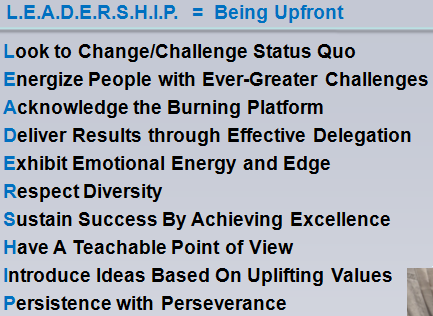by Mike Ososki, PMP, Communications Committee
It’s hard to imagine more big-picture content being packed into one Dunwoody Dinner presentation. Yet with a title like “Project Managers as Senior Executives,” Dr. Frank Harper did an admirable job to cover the ground. As a subtitle tie-in to PMI, it’s “A.G.I.L.E. L.E.A.D.E.R.S.H.I.P with a G.R.I.P.,” and to add a bit of zip, Dr. Harper’s sub-subtitle is “A Twenty-first Century Strategic Hustler™ Leadership Behavior Framework.” Whew—even the titling well portends the volume of content ahead.
Frank has achieved an incredible 96% project success rate with an amazingly long list of marquee clients. To begin, he categorizes from the perspectives of strategy, posture, and culture. For example ...

From there, we embark on a series of high level, big-picture diagrams and flow charts, including ...
• Adaptable Business Network, focused on the Operations, Tactics, and Strategies to Procure, Produce, Distribute, and Sell.
• Strategic Hustler – Orchestrates Business Transformation, including the Strategy Loop to manage the direction of Strategy, Value, and Risk, and the Feedback Loop to enable managing Business Process, Transformational IT, Organizational Change, and Competence and Training. These 2 loops then overlap in our executive-level thinking from Program and Project Management perspectives.
• Transformational Lifecycle, where phases of iterative processes loop through recurring cycles to ...
o Envision – Create the case for change, sense of urgency, and strategy/vision.
o Engage – Empower people to act on the vision and plan the effort.
o Transform – Change behavior, processes, technology, culture, and values.
o Optimize – Internalize, institutionalize and optimize transformation; create stability.
• The Business Ecosystem & Strategic Rudder “circuit board” that includes interconnections and critical questions to ask regarding your organization, its environmental influences, resources, stakeholders, market, and competition.
• Integrated Logic to Strategic Planning and Management “pyramid” covering mission, vision, strategy, objectives, roadmapping, metrics, and initiatives in steps from 30,000 feet to ground level, again asking the most important questions at each stage, from each perspective.
• The House of Strategic Execution, where engaged leadership and interactive communication is the foundation for pillars of operational excellence, sustainability, product innovation, and strategic partnering, supporting the ceiling of strategic results under a roof of mission/vision.
• The Strategic Enabler diagram that includes our familiar steps to initiate, plan & analyze, execute & monitor, and close projects, while managing processes and change.
Then, in the overall arching attitude and goals to be flexible, upfront, and in-control, as mnemonic devices, we add ...
A.G.I.L.E. – Flexible behavior to Adapt, be Goal-oriented, Intelligent, Learning, and Effective.

... with an In-Control G.R.I.P to manage Goals, Resources, Interface, and Performance.
To expand a little more on Performance, did you know that only 10% of organizations execute their strategies? Here are the barriers ...

“I” deliver Intelligent solutions ...
• Innovate – for our future.
• Insight – to invent new systems that provide 21st century solutions to our daunting array of challenges.
• Initiate – embrace your feelings to get into the game with gusto!
• Influence – turnaround and LOOK
• Interpersonal – skills to be self- and socially-aware, and self-manage.
• Integrity – with courage to meet the demands of your reality.
“Don’t downgrade your dream just to fit your reality. Upgrade your conviction to match your destiny.” – Stuart Scott
“If you don’t like where you are, change it. You’re not a tree.” – Jim Rohn
“I’ve missed more than 9000 shots in my career. I’ve lost almost 300 games. 26 times, I’ve been trusted to take the game-winning shot, and missed. I’ve failed over and over and over again in my life. And that is why I succeed. – Michael Jordan
As you manage your projects and programs in a wide variety of company and cultural contexts, the above content is great counsel on how to think like an Executive. Executive-type roles in your company are typically your primary stakeholders, so you will do well to strive and grasp as much big picture as you can, like they do every day. Dr. Harper is very well-qualified to expand you in this direction. Live Your Creed.

